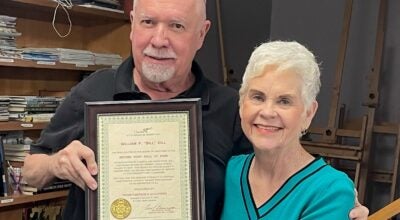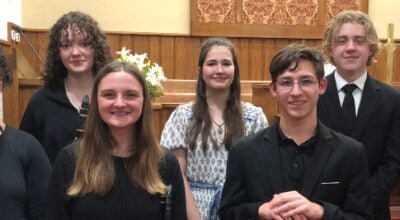Richard Sharkey designing the look of Les Misrables
Published 3:00 am Thursday, June 18, 2009
As rehearsals started at the beginning of June with the students for this summer&squo;s Tryon Little Theatre/Tryon Youth Center teen musical, I stopped by the TLT Workshop to meet the newest member of the production team for this year&squo;s show Richard Sharkey. How long have you been in Tryon? My wife and I moved up in August 2007 from Tampa, Florida where I&squo;d been working at the University of Tampa. I was their resident lighting and set person that does anything that needs to be done except costuming. I taught a theatre class for the university. I&squo;ve taught stage craft at a couple of different universities. I primarily worked with professional theatre companies though until I started working with the University of Tampa. Then I said, &dquo;Whoever gave me a regular salary could have me full time and I wouldn&squo;t work any where else.&dquo; Finally, I wrote a letter to president of the University of Tampa saying it&squo;s ridiculous that a university this large of a theatre department doesn&squo;t have a full time tech person. I worked there from 1989 until I retired about four years ago. You had a good long stint at the university then. Yeah, fifteen years. I worked with theatres that used the University so I was really familiar with the space and I did a lot of freelance for them in places. Another company that I worked for, Stageworks, did their performing in there around the university schedule. What type of lighting equipment have you worked with? When I first started at the University of Houston, I went to school in 1963, they had a little theatre and in the attic there were twelve rheostat dimmers and if you wanted to do a fade out it took twelve people. I used a lot of different types of things, but I&squo;ve been using a computer lighting board for a long time and I&squo;m really happy with it because it does the same thing every time. In the middle of my college years they switched over to a computer system for the first time. There were so many new things possible with the computer board. How did you train yourself up from the old rheostat dimmers to the computer technology available now? First of all, I love computers since they first came out in the early 80&squo;s and the video games were type entry like, &dquo;Look west&dquo; and it would say, &dquo;West is a tree with a hole under it.&dquo; My brother-in-law was trying to sell and make computers at that time. I got involved in computers and my brother is a musician and computer draftsman. He could never really make enough money to play music full time so he started doing drafting for a company in Houston. I bought my first computer which was an Amiga, and then Don gave me a regular computer with CAD on it. I started doing all the designs on CAD. Really crude when you look back on it, I can&squo;t believe that at the time it was great. I&squo;ve been a computer person all along really. I use a computer program for lighting. I first started working when I got out of college at the Showboat Dinner Theatre which is an equity theatre in St. Petersburg that brought in the stars. They had eighteen dimmers on the wall in a preset board and I would cut out a piece of paper so when I did the fade up I would bring the paper up and it would move the dimmers. So you could move them all at the same time? It had little cross-fader thing, but when you&squo;re doing a big show that&squo;s tough. One time we did a production of Cabaret and I had almost 600 light cues in it. It was five different dimmer boards working together and my wife ran part of it and I ran part of it. It could be a lot of fun and a real challenge. 600 light cues in a two hour show is&ellip; That&squo;s about five a minute. That&squo;s a lot. We treated it somewhat as a rock show particularly for the girls that were performing in the Cabaret. Les Miz is going to have lots of flashing lights too because of the battle scene and the barricade with the smoke and everything. Did you study lighting design in college? I went into college very na¨ve. I was seventeen and very young and all I wanted to do was theatre, but I had a lot of trouble with professors. I ended up on academic probation. I went into the service and ended up in Tokyo. I went to an audition for a theatre over there and ended up running a little theatre company in Tokyo for two years, which was wonderful. That&squo;s where I started designing. I&squo;d been interested in lights all along. In my first year of college I would sneak into the theatre and let them lock the building and I would go play with the lights for six or seven hours and then I would go down and sleep on a cot for an hour or two and when the students started coming in I&squo;d wake up and go to class. Basically, that&squo;s where I learned how to light shows and what lighting does. I refined that over the years. I see things in light and I can look at the space and I can visualize the set, which is a gift. I thought everyone could do that, but they can&squo;t. Now CAD makes it really easy because I can create three dimensional drawings and look at it and see what it&squo;s going to look like from back stage or the side and where the sightline problems are. You also are designing the set for Les Miz? I&squo;m working with Chris on it and we&squo;re talking about things. I&squo;m sure some of his influence will be in the set and some of my influence will be in the set. Were you originally from Houston? No, I actually grew up in Denver, Colorado until my senior year when we moved to Houston. I went to high school, one year of college and then went into the service, which is probably the best thing that ever happened to me. They sent me to Indiana University and I studied Russian for nine months. I was supposed to be a Russian linguist but they decided they had too many people, so they put me in what they called a TRANSEC unit. This was during the Viet Nam war. Three weeks into basic training the Gulf of Tonkin incident happened where we&squo;re basically at war and I&squo;m going, &dquo;Why did I enlist?&dquo; Did you end up going to Viet Nam? No, I ended up in Tokyo at a TRANSEC unit where we monitored American communications pretending we were Chinese or the Soviets to see what intelligence we got. I sat in a little building with a trunk line from Hawaii and we picked what phone lines we wanted to listen to. If we did that today people would arrest us. They made it illegal in 1971 or &squo;72 to just listen to anything that you want to. So, I met a girl in Japan who went to University of South Florida. The west coast of Florida sounded pretty good, sun and fun. I went to USF and graduated from there and went to work at the Showboat Dinner Theatre. Showboat needed someone to help on the set. It was Don Ameche and the guy who was directing decided they had to build all the furniture for the set and they were hopelessly behind. They brought me in to help catch up and I caught up and they offered me a job and eventually I took over lighting and set design. The Showboat was wonderful. It was an equity star theatre. They brought in all the people I&squo;d dreamed about meeting when I was a kid, Ozzie and Harriet, Gale Storm, Bob Cummings, Cesar Romero, Martha Ray, all these people that I&squo;d seen in movies forever and I finally got to work with them. I did three sets for Cesar, and two for Martha and Elkie Summers. I did a couple sets for Bob Crane before he was killed. It was a fun seven years. I enjoyed it, but I got tired of doing big musical comedies and a little theatre company, The Alice People, asked if I&squo;d come design for them. They did the show about the Alice People involved with the Manhattan Project which is a very bizarre, strange Alice in Wonderland. It&squo;s not a children&squo;s show. They took their name from the first production that they did. I started designing for both companies. I did this for two years. I don&s
quo;t know how I did it because my normal day would have me up at six and over at the Showboat to build sound and music until five thirty, stop at the Chinese place and get something to eat on the way, start rehearsal at six thirty or seven, rehearse until ten or eleven, go home, get up the next morning, and go do it again. I was designing and building about 22 productions a year at that point. That&squo;s a lot. The Showboat would basically do a new show every five weeks unless they did a musical. When they did the Sound of Music, which I had to run lights on, it ran for nine and a half months, something like 378 performances. The set for Beyond Therapy designed by Richard Sharkey (photo submitted) I&squo;ll show you a set I did. There&squo;s a play by one of the Southern female playwrights called The Old Timers Game. I did sets with painted floors like this one. It looks like a real wood grain floor, but it&squo;s just paint? Yes. That&squo;s beautiful. The Old Timers Game took place in a dugout. We built everything and had Styrofoam bricks. I have some really great compliments from this show. One was a St. Petersburg artist came in and said, &dquo;Wow, the paint job on this was incredible.&dquo; I had beams that came out like in the stadium with all kinds of aging stuff on it. The other thing that was really neat was, a father brought his little son to this show and at the end he turned to his dad and said, &dquo;Dad, why didn&squo;t we watch the baseball game?&dquo; I went, &dquo;Yes! It works.&dquo; That&squo;s the magic of theatre. It&squo;s going to be fun to work here with a theatre company that the people are here and they want to do it. They want to be involved in it. The Tryon Little Theatre has a good team that works together to make these shows. Where are you at for the design of Les Mis´rables at this point? We have the basic design, but there are still a lot of questions that aren&squo;t answered. We have a revolve in the middle that turns around and becomes the barricade for the beginning of act two. I know there&squo;s a bridge that&squo;s going to be flown in that I will have to design. It&squo;s in my head. The flying bridge is going to happen? Yes, the flying bridge is going to happen. I&squo;ve got to find out about the lighting equipment and what we&squo;ll be able to do with the lights for that scene. There are three elements about lighting, lighting the performer, lighting the set, and creating the mood. In Les Miz we&squo;re going for a period feel so I know we&squo;re going to use amber and blues from the front and light from the back. And this opens&ellip; July 9. I know it&squo;s going to be fun and exciting. Les Miz is a big show. It&squo;s a very ambitious show. CATS was an ambitious show and they said they did wonderful. Chris talks about how he&squo;d rather do intelligent, hard shows. The kids pulled it off last year. I can&squo;t wait to see how they do with the challenge this year. If people are interested in contacting you about projects or ideas about upcoming shows is there a way for them to reach you? They could reach me through Tryon Little Theatre or at my home phone 828-749-3810. Look for Richard Sharkey&squo;s design debut at the Tryon Fine Arts Center this summer with the TLT/TYC teen musical Les Mis´rables. The box office opens at the TLT Workshop on June 22 for advance ticket sales. The production will run one weekend July 9-12. For more information contact the TLT Workshop at 828-859-2466 or www.tltinfo.org.





